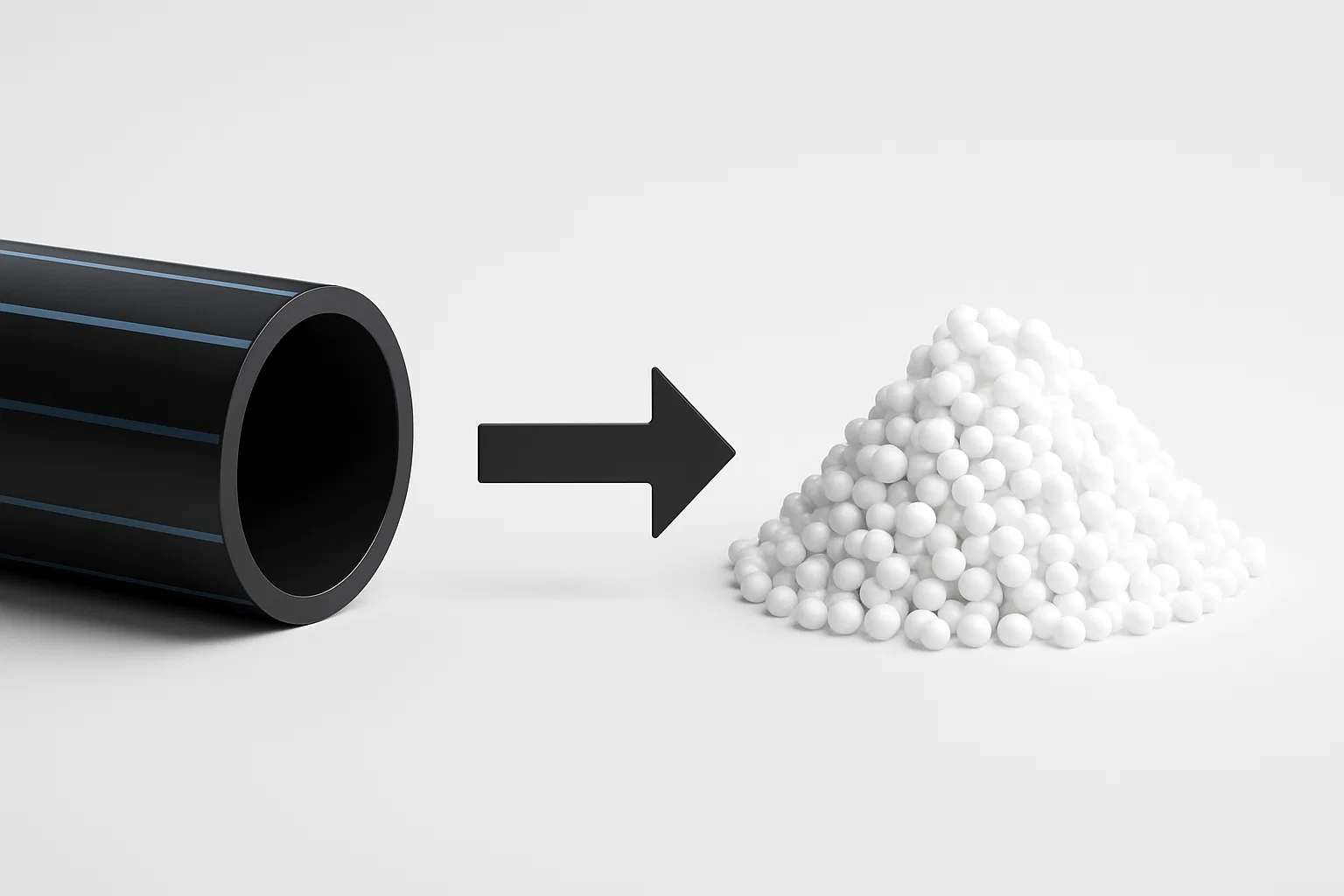In der Welt der Industriekunststoffe zeichnet sich Polyethylen hoher Dichte (HDPE) durch seine Langlebigkeit, Korrosionsbeständigkeit und Vielseitigkeit aus. Es bildet das Rückgrat moderner Infrastruktur und wird in allen Bereichen eingesetzt, von kommunalen Wassersystemen und der Gasverteilung bis hin zu Telekommunikationsleitungen. Angesichts der Millionen Tonnen produzierter und letztendlich ersetzter HDPE-Rohre stellt sich jedoch die entscheidende Frage: Was geschieht mit diesem wertvollen Material am Ende seiner Lebensdauer?
Die Antwort liegt in einem robusten und rentablen Recyclingprozess.
Für industrielle Recyclingunternehmen, Bauunternehmer und kommunale Abfallentsorger stellen ausrangierte HDPE-Rohre keine Belastung dar, sondern eine wertvolle Ressource, die nur darauf wartet, erschlossen zu werden. Dieser ultimative Leitfaden führt Sie Schritt für Schritt durch den gesamten Recyclingprozess von HDPE-Rohren und zeigt Ihnen, wie Sie aus einem sperrigen Abfallstrom eine attraktive Einnahmequelle machen.
Kapitel 1: Der HDPE-Rohrrecyclingprozess: Eine Schritt-für-Schritt-Anleitung
Die Umwandlung eines 15 Meter langen, dickwandigen Rohrs in wiederverwendbare Kunststoffpellets ist ein mehrstufiger Prozess. Jeder Schritt ist entscheidend für die Qualität und den Marktwert des Endprodukts.
Schritt 1: Sammeln und Sortieren
Der Prozess beginnt an der Quelle. HDPE-Rohre werden auf Baustellen, bei Infrastrukturprojekten und in Industrieanlagen gesammelt. In dieser Phase ist es wichtig, die Rohre zu sortieren und HDPE (Kunststoff #2) von anderen Materialien wie PVC oder Metallfittings zu trennen. Zwar sind gewisse Verunreinigungen unvermeidlich, doch eine gute anfängliche Sortierung vereinfacht den nachfolgenden Prozess.
Schritt 2: Primärreinigung
Gesammelte Rohre sind oft mit Schmutz, Schlamm oder anderen Ablagerungen bedeckt. Eine Vorwäsche entfernt diese Oberflächenverunreinigungen und schützt so die Verarbeitungsanlagen in den nächsten Schritten vor übermäßigem Verschleiß.
Schritt 3: Größenreduzierung – Die kritische Zerkleinerungsphase
Dies ist der anspruchsvollste und wichtigste Schritt beim Recycling von HDPE-Rohren. Aufgrund ihres großen Durchmessers, ihrer Länge und ihrer robusten Wände können HDPE-Rohre nicht direkt einem Granulator zugeführt werden. Sie müssen zunächst in kleinere, handliche Stücke zerlegt werden.
Hier kommt ein drehmomentstarker Industrie- HDPE-Rohrzerkleinerer wird zum Herzstück des Betriebs. Im Gegensatz zu Hochgeschwindigkeitsgranulatoren arbeitet ein Shredder mit niedriger Geschwindigkeit und enormem Drehmoment, was ihm Folgendes ermöglicht:
- Greifen und hineinziehen große, sperrige Rohre ohne Schwierigkeiten.
- Durch dicke Wände schneiden sauber und effizient, wodurch Staus vermieden werden.
- Umgang mit mäßiger Kontamination wie Restschmutz, ohne dass die Klingen nennenswert beschädigt werden.
Das Ergebnis des Schredders sind gleichmäßig große, grobe Kunststoffspäne (typischerweise 40–100 mm), die nun perfekt für die nachfolgenden Verarbeitungsschritte geeignet sind.
Schritt 4: Sekundärwäsche und Trennung
Die zerkleinerten HDPE-Chips werden einem intensiveren Reinigungsprozess unterzogen. Sie werden typischerweise in einen Friktionswascher oder einen Schwimm-Sink-Tank gegeben. Im Schwimm-Sink-Tank schwimmt das HDPE mit einer Dichte von weniger als 1 g/cm³, während schwerere Verunreinigungen wie Metallfragmente, Steine oder andere Kunststoffe (z. B. PVC) absinken. Dies ist ein äußerst effektiver Reinigungsschritt.
Schritt 5: Trocknen
Zur Vorbereitung auf das Schmelzen muss die gesamte Feuchtigkeit aus den Kunststoffspänen entfernt werden. Die sauberen Späne werden durch einen thermischen oder Zentrifugaltrockner geleitet, bis der Feuchtigkeitsgehalt extrem niedrig ist. Unvollständige Trocknung kann die Qualität der fertigen Pellets beeinträchtigen.
Schritt 6: Schmelzen und Pelletieren (Extrusion)
Die trockenen, sauberen HDPE-Chips werden nun einem Extruder zugeführt. Dort werden sie erhitzt, geschmolzen und zu einer gleichmäßigen Kunststoffschmelze homogenisiert. Diese wird anschließend durch eine Düse gepresst, wodurch lange, spaghettiähnliche Stränge entstehen. Diese Stränge werden sofort in einem Wasserbad abgekühlt und von einem Pelletierer in kleine Pellets geschnitten.
Diese Pellets sind das Endprodukt – ein hochwertiger, recycelter Rohstoff, der verkauft und zur Herstellung neuer Produkte verwendet werden kann.
Kapitel 2: Warum der Aktenvernichter Ihre wichtigste Investition ist
Für alle, die das Recycling von HDPE-Rohren ernst nehmen, ist die Wahl der Zerkleinerungsanlage von größter Bedeutung. Ein Granulator eignet sich zwar hervorragend für kleinere, spröde Kunststoffe, ist jedoch für die Erstverarbeitung großer Rohre ungeeignet.
Investition in ein speziell gebautes Zerkleinerer für HDPE-Rohre ist keine Ausgabe, sondern eine wichtige Investition in die betriebliche Effizienz. Wichtige Merkmale, auf die Sie achten sollten, sind:
- Motor mit hohem Drehmoment und niedriger Geschwindigkeit: Unverzichtbar, um die nötige Leistung für die Verarbeitung zäher Materialien bereitzustellen, ohne dass die Gefahr einer Überhitzung oder Verstopfung besteht.
- Robuste, verschleißfeste Klingen: Das Schneidsystem muss so konstruiert sein, dass es der abrasiven Natur von HDPE und potenziellen Verunreinigungen standhält.
- Große Einfüllöffnung: Der Zerkleinerer muss für die großen Durchmesser der zu verarbeitenden Rohre geeignet sein.
- Intelligentes Steuerungssystem: Moderne Aktenvernichter verfügen über eine automatische Rücklauffunktion, die mögliche Staus automatisch beseitigt und so einen kontinuierlichen und unbemannten Betrieb gewährleistet.
Kapitel 3: Der Markt für recycelte HDPE-Pellets
Die Nachfrage nach hochwertigem recyceltem HDPE ist stark und wächst stetig, angetrieben durch Nachhaltigkeitsziele von Unternehmen und gesetzliche Vorschriften. Die von Ihnen produzierten Pellets können an Hersteller verkauft werden, um eine breite Palette neuer Produkte herzustellen, darunter:
- Neue, drucklose Rohre (z. B. für die Entwässerung oder landwirtschaftliche Bewässerung)
- Verbundholz für Terrassendielen und Gartenmöbel
- Kunststoffbehälter, -kisten und -paletten
- Autoteile
- Plastiktüten und Folien
Fazit: Von der Herausforderung zur Chance
Das Recycling von HDPE-Rohren bietet bedeutende ökologische und wirtschaftliche Chancen. Was als logistische Herausforderung beginnt – die Entsorgung sperriger, gebrauchter Rohre – kann mit dem richtigen Verfahren und der richtigen Technologie zu einem profitablen Geschäftszweig werden.
Der Weg vom Altrohr zum wertvollen Pellet hängt von einem effizienten, leistungsstarken und zuverlässigen Zerkleinerungsprozess ab. Wenn Sie jeden Schritt verstehen und die zentrale Rolle eines robusten HDPE-Rohrzerkleinerers erkennen, kann Ihr Unternehmen diesen wachsenden Markt effektiv erschließen und Industrieabfälle in industriellen Wert verwandeln.
Bereit für den Aufbau Ihres Recyclingbetriebs? Kontaktieren Sie unser Engineering-Team, um die passende Zerkleinerungslösung für Ihre spezifischen Anforderungen zu besprechen.



